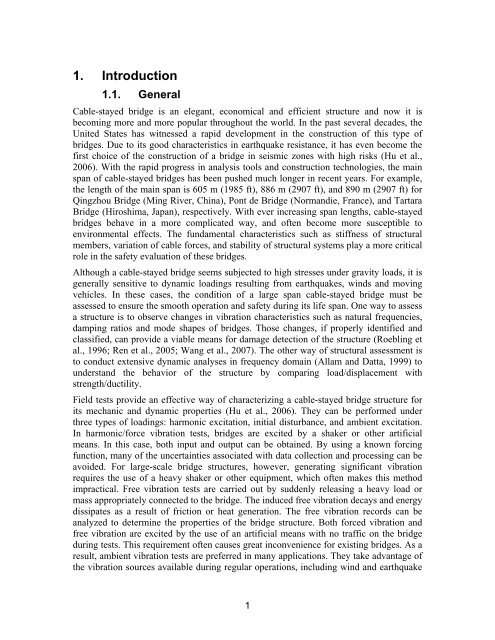Assessment of the Bill Emerson Memorial Bridge - FTP Directory ...
Assessment of the Bill Emerson Memorial Bridge - FTP Directory ...
Assessment of the Bill Emerson Memorial Bridge - FTP Directory ...
- No tags were found...
You also want an ePaper? Increase the reach of your titles
YUMPU automatically turns print PDFs into web optimized ePapers that Google loves.
1. Introduction1.1. GeneralCable-stayed bridge is an elegant, economical and efficient structure and now it isbecoming more and more popular throughout <strong>the</strong> world. In <strong>the</strong> past several decades, <strong>the</strong>United States has witnessed a rapid development in <strong>the</strong> construction <strong>of</strong> this type <strong>of</strong>bridges. Due to its good characteristics in earthquake resistance, it has even become <strong>the</strong>first choice <strong>of</strong> <strong>the</strong> construction <strong>of</strong> a bridge in seismic zones with high risks (Hu et al.,2006). With <strong>the</strong> rapid progress in analysis tools and construction technologies, <strong>the</strong> mainspan <strong>of</strong> cable-stayed bridges has been pushed much longer in recent years. For example,<strong>the</strong> length <strong>of</strong> <strong>the</strong> main span is 605 m (1985 ft), 886 m (2907 ft), and 890 m (2907 ft) forQingzhou <strong>Bridge</strong> (Ming River, China), Pont de <strong>Bridge</strong> (Normandie, France), and Tartara<strong>Bridge</strong> (Hiroshima, Japan), respectively. With ever increasing span lengths, cable-stayedbridges behave in a more complicated way, and <strong>of</strong>ten become more susceptible toenvironmental effects. The fundamental characteristics such as stiffness <strong>of</strong> structuralmembers, variation <strong>of</strong> cable forces, and stability <strong>of</strong> structural systems play a more criticalrole in <strong>the</strong> safety evaluation <strong>of</strong> <strong>the</strong>se bridges.Although a cable-stayed bridge seems subjected to high stresses under gravity loads, it isgenerally sensitive to dynamic loadings resulting from earthquakes, winds and movingvehicles. In <strong>the</strong>se cases, <strong>the</strong> condition <strong>of</strong> a large span cable-stayed bridge must beassessed to ensure <strong>the</strong> smooth operation and safety during its life span. One way to assessa structure is to observe changes in vibration characteristics such as natural frequencies,damping ratios and mode shapes <strong>of</strong> bridges. Those changes, if properly identified andclassified, can provide a viable means for damage detection <strong>of</strong> <strong>the</strong> structure (Roebling etal., 1996; Ren et al., 2005; Wang et al., 2007). The o<strong>the</strong>r way <strong>of</strong> structural assessment isto conduct extensive dynamic analyses in frequency domain (Allam and Datta, 1999) tounderstand <strong>the</strong> behavior <strong>of</strong> <strong>the</strong> structure by comparing load/displacement withstrength/ductility.Field tests provide an effective way <strong>of</strong> characterizing a cable-stayed bridge structure forits mechanic and dynamic properties (Hu et al., 2006). They can be performed underthree types <strong>of</strong> loadings: harmonic excitation, initial disturbance, and ambient excitation.In harmonic/force vibration tests, bridges are excited by a shaker or o<strong>the</strong>r artificialmeans. In this case, both input and output can be obtained. By using a known forcingfunction, many <strong>of</strong> <strong>the</strong> uncertainties associated with data collection and processing can beavoided. For large-scale bridge structures, however, generating significant vibrationrequires <strong>the</strong> use <strong>of</strong> a heavy shaker or o<strong>the</strong>r equipment, which <strong>of</strong>ten makes this methodimpractical. Free vibration tests are carried out by suddenly releasing a heavy load ormass appropriately connected to <strong>the</strong> bridge. The induced free vibration decays and energydissipates as a result <strong>of</strong> friction or heat generation. The free vibration records can beanalyzed to determine <strong>the</strong> properties <strong>of</strong> <strong>the</strong> bridge structure. Both forced vibration andfree vibration are excited by <strong>the</strong> use <strong>of</strong> an artificial means with no traffic on <strong>the</strong> bridgeduring tests. This requirement <strong>of</strong>ten causes great inconvenience for existing bridges. As aresult, ambient vibration tests are preferred in many applications. They take advantage <strong>of</strong><strong>the</strong> vibration sources available during regular operations, including wind and earthquake1
















